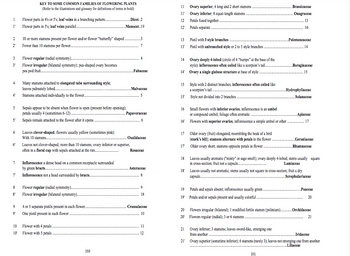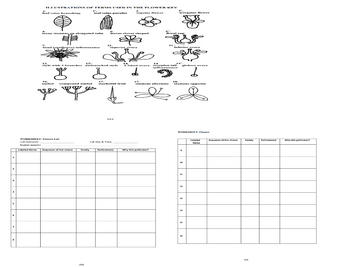
Human Anatomy & Physiology (11th Edition)
11th Edition
ISBN: 9780134580999
Author: Elaine N. Marieb, Katja N. Hoehn
Publisher: PEARSON
expand_more
expand_more
format_list_bulleted
Concept explainers
Question
Follow the key on page 1 to direct the steps, alongside with it's illustration of key on page 2, to fill out the sheets on the second page of the each of the directed 16 species' labeled name, sequence of line choice, family, pollinator(s), and why this pollinator. Thank you.

Transcribed Image Text:יד
1 Flower parts in 4's or 5's; leaf veins in a branching patter..............
l'
Flower parts in 3's; leaf veins parallel..
2
10 or more stamens present per flower and/or flower "butterfly" shaped
2'
Fewer than 10 stamens per flower.
3
Flower regular (radial symmetry)...
3'
Flower irregular (bilateral symmetry); pea-shaped ovary becomes
pea pod fruit.....
4
Many stamens attached to elongated tube surrounding style;
leaves palmately lobed....
4'
Stamens attached individually to the flower......
5
Sepals appear to be absent when flower is open (present before opening);
petals usually 4 (sometimes 6-12).....
5'
Sepals remain attached to the flower after it opens
6
Leaves clover-shaped; flowers usually yellow (sometimes pink)
With 10 stamens......
6'
Leaves not clover-shaped; more than 10 stamens; ovary inferior or superior,
often in a floral cup with sepals attached at the rim....
7
Inflorescence a dense head on a common receptacle surrounded
by green bracts..
Inflorescence not a head surrounded by bracts.
Flower regular (radial symmetry)...
Flower irregular (bilateral symmetry)..
4 or 5 separate pistils present in each flower..
One pistil present in each flower
10
Flower with 4 petals.
10 Flower with 5 petals
150
KEY TO SOME COMMON FAMILIES OF FLOWERING PLANTS
(Refer to the illustrations and glossary for definitions of terms in bold)
..Dicot..2
...Monocot..19
3
7
8
8¹
9
9'
4
..Fabaceae
Malvaceae
5
Papaveraceae
6
Oxalidaceae
Rosaceae
Asteraceae
8
9
18
Crassulaceae
10
11
12
11
Ovary superior, 4 long and 2 short stamens.
. Brassicaceae
11'
Ovary inferior; 8 equal-length stamens
Onagraceae
12
Petals fused together....
13
12
Petals separate.
16
13 Pistil with 3 style branches.
..Polemoneaceae
14
13'
Pistil with unbranched style or 2 to 5 style branches.
14
Ovary deeply 4-lobed (circle of 4 "bumps" at the base of the
style); inflorescence often coiled like a scorpion's tail.
...Boraginaceae
.......................... 15
14
Ovary a single globose structure at base of style.
15
Style with 2 distinct branches; inflorescence often coiled like
a scorpion's tail.....
..Hydrophyllaceae
...Solanaceae
15'
Style not divided into 2 branches
16
Small flowers with inferior ovaries; inflorescence is an umbel
or compound umbel; foliage often aromatic
..Apiaceae
16' Flowers with superior ovaries; inflorescence a simple umbel or other................ 17
17 Older ovary (fruit) elongated, resembling the beak of a bird
(stork's bill); stamens alternate with petals in the flower
Geraniaceae
Rhamnaceae
17 Older ovary short; stamens opposite petals in flower......
18 Leaves usually aromatic ("minty" or sage smell); ovary deeply 4-lobed; stems usually square
in cross-section; fruit not a capsul..............
Lamiaceae
18' Leaves usually not aromatic; stems usually not square in cross-section; fruit a dry
capsule..........
......Scrophulariaceae
... Poaceae
20
19
Petals and sepals absent; inflorescence usually green.
19 Petals and/or sepals present and usually colorful.
20 Flowers irregular (bilateral); 1 modified fertile stamen (polinium).
Orchidaceae
21
20 Flowers regular (radial); 3 or 6 stamens
21 Ovary inferior; 3 stamens; leaves sword-like, emerging one
from another.
Iridaceae
21 Ovary superior (sometime inferior); 6 stamens (rarely 3); leaves not emerging one from another
Liliaceae
******
151

Transcribed Image Text:1
S
ILLUSTRATIONS OF TERMS USED IN THE FLOWER KEY
af veins branching
regular flower
leaf veins parallel
many stamens of
elongated tube
head (sent yer) inflorescence
13.
13%.
style with 3 branches
टै
Ś
17.
16.
umbet
compound umbet
xtorkabill fruit
даво чере
$₂
152
Lab Day & Time:
Pallinator(s)
WORKSHEET: Flowers Lab
Lab Instructor:
Student num();
Labeled Name Sequence of line choice
Family
155
11.
superior overy
14ed ovary
d
Why this pollinator?
irregular flower
floral cup
17.
stamcnx alternate
11 inferior ova
14.
&
14
scorpion tail
globose ovary
d
IN.
stamenx opposite
WORKSHEET: Flowers
Labeled
Nume
9
10
11
12
14
15
16
Sequence of line choice
Family
156
Pollinator(1)
Why this pollinator?
Expert Solution
This question has been solved!
Explore an expertly crafted, step-by-step solution for a thorough understanding of key concepts.
This is a popular solution
Trending nowThis is a popular solution!
Step by stepSolved in 3 steps

Knowledge Booster
Learn more about
Need a deep-dive on the concept behind this application? Look no further. Learn more about this topic, biology and related others by exploring similar questions and additional content below.Similar questions
- helparrow_forward# of Green Leaves _________111______________ # of White Leaves ___________35______________ What is the expected ratio of white to green F2 tobacco plants (give phenotype not genotype)? Back up your answer with a Punnett squarearrow_forwardPlease help me make an indented dichotomous key. I WANT COMPLETE ANSWERS PLEASE I DON'T WANT THE SAME ANSWER FROM OTHERS. EXAMPLES IS GIVENarrow_forward
- # of Green Leaves _________111______________ # of White Leaves ___________35______________ What is the expected ratio of white to green F2 tobacco plants (give phenotype not genotype)? Back up your answer with a Punnett squarearrow_forwardWhat part of the pea pod is the seed? Select an answer and submit. For keyboard navigation, use the up/dow a b с The Shell/Pod The Peas The Stemarrow_forward
arrow_back_ios
arrow_forward_ios
Recommended textbooks for you
 Human Anatomy & Physiology (11th Edition)BiologyISBN:9780134580999Author:Elaine N. Marieb, Katja N. HoehnPublisher:PEARSON
Human Anatomy & Physiology (11th Edition)BiologyISBN:9780134580999Author:Elaine N. Marieb, Katja N. HoehnPublisher:PEARSON Biology 2eBiologyISBN:9781947172517Author:Matthew Douglas, Jung Choi, Mary Ann ClarkPublisher:OpenStax
Biology 2eBiologyISBN:9781947172517Author:Matthew Douglas, Jung Choi, Mary Ann ClarkPublisher:OpenStax Anatomy & PhysiologyBiologyISBN:9781259398629Author:McKinley, Michael P., O'loughlin, Valerie Dean, Bidle, Theresa StouterPublisher:Mcgraw Hill Education,
Anatomy & PhysiologyBiologyISBN:9781259398629Author:McKinley, Michael P., O'loughlin, Valerie Dean, Bidle, Theresa StouterPublisher:Mcgraw Hill Education, Molecular Biology of the Cell (Sixth Edition)BiologyISBN:9780815344322Author:Bruce Alberts, Alexander D. Johnson, Julian Lewis, David Morgan, Martin Raff, Keith Roberts, Peter WalterPublisher:W. W. Norton & Company
Molecular Biology of the Cell (Sixth Edition)BiologyISBN:9780815344322Author:Bruce Alberts, Alexander D. Johnson, Julian Lewis, David Morgan, Martin Raff, Keith Roberts, Peter WalterPublisher:W. W. Norton & Company Laboratory Manual For Human Anatomy & PhysiologyBiologyISBN:9781260159363Author:Martin, Terry R., Prentice-craver, CynthiaPublisher:McGraw-Hill Publishing Co.
Laboratory Manual For Human Anatomy & PhysiologyBiologyISBN:9781260159363Author:Martin, Terry R., Prentice-craver, CynthiaPublisher:McGraw-Hill Publishing Co. Inquiry Into Life (16th Edition)BiologyISBN:9781260231700Author:Sylvia S. Mader, Michael WindelspechtPublisher:McGraw Hill Education
Inquiry Into Life (16th Edition)BiologyISBN:9781260231700Author:Sylvia S. Mader, Michael WindelspechtPublisher:McGraw Hill Education

Human Anatomy & Physiology (11th Edition)
Biology
ISBN:9780134580999
Author:Elaine N. Marieb, Katja N. Hoehn
Publisher:PEARSON

Biology 2e
Biology
ISBN:9781947172517
Author:Matthew Douglas, Jung Choi, Mary Ann Clark
Publisher:OpenStax

Anatomy & Physiology
Biology
ISBN:9781259398629
Author:McKinley, Michael P., O'loughlin, Valerie Dean, Bidle, Theresa Stouter
Publisher:Mcgraw Hill Education,

Molecular Biology of the Cell (Sixth Edition)
Biology
ISBN:9780815344322
Author:Bruce Alberts, Alexander D. Johnson, Julian Lewis, David Morgan, Martin Raff, Keith Roberts, Peter Walter
Publisher:W. W. Norton & Company

Laboratory Manual For Human Anatomy & Physiology
Biology
ISBN:9781260159363
Author:Martin, Terry R., Prentice-craver, Cynthia
Publisher:McGraw-Hill Publishing Co.

Inquiry Into Life (16th Edition)
Biology
ISBN:9781260231700
Author:Sylvia S. Mader, Michael Windelspecht
Publisher:McGraw Hill Education